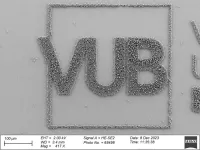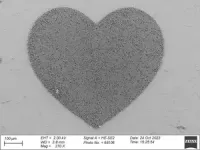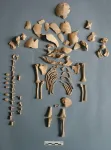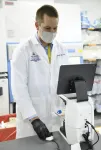(Press-News.org) Researchers from the Department of Chemical Engineering at the Vrije Universiteit Brussel, Riga Technical University and the MESA+ Institute at the University of Twente have succeeded in arranging very small particles (10 µm to 500 nm, 10 to 100 times thinner than a human hair) in a thin layer without using solvents. This is a hugely important first step towards developing a new generation of sensors and electronics for a wide range of applications.
“Common methods based on crystallising solutions are not as versatile as we would like. What’s more, previous dry methods were mainly effective on sticky surfaces, which limited their applications,” says Ignaas Jimidar of the VUB. To address this issue, the team devised a method of attaching the particles on hard and non-sticky surfaces. They rubbed the particles across the surface by hand, and within about 20 seconds achieved a single layer of densely packed particles arranged in a hexagonal pattern. “The rubbing is done using a stamp made of a silicone-like material called PDMS,” says Kai Sotthewes of the University of Twente. “The static electricity generated by the rubbing process, especially on harder surfaces, and the forces between the particles and the surface are crucial for creating the desired patterns. We encounter this static electricity in everyday life, if we rub a balloon against our hair or feel a shock on a dry winter day when we touch a metal object.”
“The pattern-making process worked on both conductive and non-conductive surfaces, and the best results were achieved with certain types of particle powders, such as polystyrene (used as insulation) and polymethyl methacrylate or PMMA, also known as Plexiglas,” says Andris Šutka of Riga Technical University. Silica, a ubiquitous component in contemporary electronics, only worked well on surfaces that were covered with fluorocarbon (a kind of Teflon layer) and when there was no humidity. “Silica particles are therefore slightly less user-friendly, but they are resistant to all kinds of solvents, which makes them suitable for biological and chemical analysis and detection techniques,” adds Gijs Roozendaal of the University of Twente.
“We eventually succeeded in creating a series of microscopic patterns and logos on ‘wafers’ on a large scale, and visualised them all using an atomic force microscope,” says Ignaas Jimidar. “This represents a promising development for improving electronics, detecting all kinds of chemical and biological substances, and even detecting counterfeit goods. The last is possible because particles in certain patterns refract light differently depending on the angle. So you could detect colours using these microparticles.”
The research was published in the journal ACS Applied Materials & Interfaces, and will appear on the cover of the print edition.
Kai Sotthewes, Gijs Roozendaal, Andris Šutka, and Ignaas S. M. Jimidar. Toward the Assembly of 2D Tunable Crystal Patterns of Spherical Colloids on a Wafer-Scale. ACS Applied Materials & Interfaces Article ASAP https://pubs.acs.org/doi/10.1021/acsami.3c16830
END
VUB researchers assemble patterns of micro- and nanoparticles
2024-02-20
ELSE PRESS RELEASES FROM THIS DATE:
Ancient DNA reveals Down syndrome in past human societies
2024-02-20
By analysing ancient DNA, an international team of researchers have uncovered cases of chromosomal disorders, including what could be the first case of Edwards syndrome ever identified from prehistoric remains.
The team identified six cases of Down syndrome and one case of Edwards syndrome in human populations that were living in Spain, Bulgaria, Finland, and Greece from as long ago as 4,500 years before today.
The research indicated that these individuals were buried with care, and often with special grave goods, showing that they were appreciated as members of their ancient societies.
The global collaborative study, led by first author Dr ...
Smiling is the secret to seeing happiness, new research reveals
2024-02-20
Smiling for just a split second makes people more likely to see happiness in expressionless faces, new University of Essex research has revealed.
The study led by Dr Sebastian Korb, from the Department of Psychology, shows that even a brief weak grin makes faces appear more joyful.
The pioneering experiment used electrical stimulation to spark smiles and was inspired by photographs made famous by Charles Darwin.
A painless current manipulated muscles momentarily into action – ...
Antil studying efficient algorithms for optimization problems with PDE constraints
2024-02-20
Harbir Antil, Professor, Mathematical Sciences; Director, Center for Mathematics and Artificial Intelligence (CMAI), received funding for the project: “Efficient Algorithms for Optimization Problems with PDE Constraints.”
Antil and his collaborators are examining generic optimization problems constrained by partial differential equations (PDEs) with or without uncertainty. In case of uncertainty, a risk-averse optimization framework will be developed. Decomposition and Compression techniques will be utilized to overcome the high computational costs. Several applications in various disciplines such ...
Age-related changes in fibroblast cells promote pancreatic cancer growth and spread
2024-02-20
Older people may be at greater risk of developing pancreatic cancer and have poorer prognoses because of age-related changes in cells in the pancreas called fibroblasts, according to research led by investigators from the Johns Hopkins Kimmel Cancer Center, the Johns Hopkins Bloomberg School of Public Health and the Bloomberg~Kimmel Institute for Cancer Immunotherapy.
The study, published online Feb. 8 in Cancer Research, provides clues as to why pancreatic cancer is more common and aggressive in older people. It may also help scientists develop ...
University of Birmingham signs pioneering collaboration agreement with Vital Energi
2024-02-20
The University of Birmingham has signed a collaboration agreement with Vital Energi to develop and commercialise a range of innovative thermal storage solutions, which will help accelerate decarbonisation within the heating and cooling sector.
The University and Vital Energi will work together over an initial four years to continue the development of thermal storage Intellectual Property (IP) with a view to bringing a number of products to market. As part of the agreement, the University has assigned several IP rights, including a number of patents, to Vital Energi.
The implementation of thermal energy storage is imperative to address the challenges posed ...
Oocytes outsmart toxic proteins to preserve long-term female fertility
2024-02-20
Oocytes are immature egg cells that develop in almost all female mammals before birth. The propagation of future generations depends on this finite reserve of cells surviving for many years without incurring damage. In mice, this can be a period of up to eighteen months, while in humans it can last almost half a century, the average time between birth and menopause. How the cells accomplish this remarkable feat of longevity has been a longstanding question.
Researchers at the Centre for Genomic ...
The Radcliffe Wave is waving
2024-02-20
A few years ago, astronomers uncovered one of the Milky Way’s greatest secrets: an enormous, wave-shaped chain of gaseous clouds in our sun’s backyard, giving birth to clusters of stars along the spiral arm of the galaxy we call home.
Naming this astonishing new structure the Radcliffe Wave, in honor of the Harvard Radcliffe Institute, where the undulation was originally discovered, the team now reports in Nature that the Radcliffe Wave not only looks like a wave, but also moves like one – oscillating through space-time much like “the wave” moving through a stadium full of fans.
Ralf Konietzka, the paper’s ...
Examining excess mortality associated with the pandemic for renters threatened with eviction
2024-02-20
About The Study: Housing instability, as measured by eviction filings, was associated with a significantly increased risk of death over the first 20 months of the COVID-19 pandemic in this study that included 282,000 renters who received an eviction filing. Eviction prevention efforts may have reduced excess mortality for renters during this period.
Authors: Nick Graetz, Ph.D., of Princeton University in Princeton, New Jersey, is the corresponding author.
To access the embargoed study: Visit ...
Fresh meat: New biosensor accurately and efficiently determines meat freshness
2024-02-20
WASHINGTON, Feb. 20, 2024 — The freshness of animal meat is an essential property determining its quality and safety. With advanced technology capable of preserving food for extended periods of time, meat can be shipped around the globe and consumed long after an animal dies. As global meat consumption rates increase, so too does the demand for effective measures for its age.
Despite the technological advances keeping meat fresh for as long as possible, certain aging processes are unavoidable. Adenosine triphosphate (ATP) ...
Large, diverse genetic study of glaucoma implicates vascular and cancer-related genes
2024-02-20
An international genetic study using multiancestry biobanks has identified novel genetic locations associated with primary open-angle glaucoma (POAG), the most common type of glaucoma and the leading cause of irreversible blindness globally. The findings, published Feb. 20 in Cell Reports Medicine, detail ancestry- and sex-specific genetic loci associated with POAG and implicate vascular and cancer-related genes in POAG risk.
“Although there has been significant progress using genome-wide association studies (GWAS) to explore the genetic pathophysiology of glaucoma in humans, there is still a lack of understanding of the underlying ...







